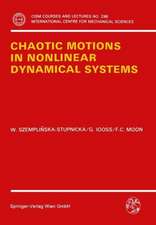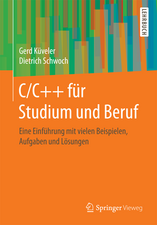Similarity and Modeling in Science and Engineering
Autor Josef Kunešen Limba Engleză Paperback – 8 mai 2014
| Toate formatele și edițiile | Preț | Express |
|---|---|---|
| Paperback (1) | 648.42 lei 6-8 săpt. | |
| Cambridge International Science Publishing Ltd. – 8 mai 2014 | 648.42 lei 6-8 săpt. | |
| Hardback (1) | 651.51 lei 6-8 săpt. | |
| Cambridge International Science Publishing Ltd. – 6 apr 2012 | 651.51 lei 6-8 săpt. |
Preț: 648.42 lei
Preț vechi: 762.85 lei
-15% Nou
Puncte Express: 973
Preț estimativ în valută:
124.09€ • 129.07$ • 102.44£
124.09€ • 129.07$ • 102.44£
Carte tipărită la comandă
Livrare economică 15-29 aprilie
Preluare comenzi: 021 569.72.76
Specificații
ISBN-13: 9781907343896
ISBN-10: 190734389X
Pagini: 460
Ilustrații: XVIII, 442 p.
Dimensiuni: 155 x 235 x 24 mm
Greutate: 0.64 kg
Ediția:2012
Editura: Cambridge International Science Publishing Ltd.
Colecția Cambridge International Science Publishing
Locul publicării:Cambridge, Austria
ISBN-10: 190734389X
Pagini: 460
Ilustrații: XVIII, 442 p.
Dimensiuni: 155 x 235 x 24 mm
Greutate: 0.64 kg
Ediția:2012
Editura: Cambridge International Science Publishing Ltd.
Colecția Cambridge International Science Publishing
Locul publicării:Cambridge, Austria
Public țintă
ResearchCuprins
From the Contents: Methodology of Modeling.- Dimensional Analysis.- Methods of Similarity Analysis.- Mathematical Models.- Physical Models.- Physical Analogs.- Computer Deterministic Models.- Computer Stochastic Models.- Cybernetic Models.
Notă biografică
M.Sc , 1949-1953
Technical University in Plzen, Faculty of Mechanical Engineering
Post-graduate study of nuclear technique , ………………………………… 1956-1959
Technical University Plzen
Ph.D. ………………………………………………………………………… 1964
Technical University in P1zen
Post-graduate study of experimental methods in mechanics …………………1964-1965
Teclmical University Dresden .
Scientific Qualification Grad I by the decision of the Presidium of the Czech. Ac. Sci. 1980
Doctor of Technical Sciences degree for the branch Thermomechanics …………….1991
Technical University Prague
Professor for the branch Technical Cybernetics ........................................................... 1991
Technical University Prague
Technical University in Plzen, Faculty of Mechanical Engineering
Post-graduate study of nuclear technique , ………………………………… 1956-1959
Technical University Plzen
Ph.D. ………………………………………………………………………… 1964
Technical University in P1zen
Post-graduate study of experimental methods in mechanics …………………1964-1965
Teclmical University Dresden .
Scientific Qualification Grad I by the decision of the Presidium of the Czech. Ac. Sci. 1980
Doctor of Technical Sciences degree for the branch Thermomechanics …………….1991
Technical University Prague
Professor for the branch Technical Cybernetics ........................................................... 1991
Technical University Prague
Textul de pe ultima copertă
The present text sets itself in relief to other titles on the subject in that it addresses the means and methodologies versus a narrow specific-task oriented approach. Concepts and their developments which evolved to meet the changing needs of applications are addressed. This approach provides the reader with a general tool-box to apply to their specific needs. Two important tools are presented: dimensional analysis and the similarity analysis methods. The fundamental point of view, enabling one to sort all models, is that of information flux between a model and an original expressed by the similarity and abstraction. Each chapter includes original examples and ap-plications. In this respect, the models can be divided into several groups. The following models are dealt with separately by chapter; mathematical and physical models, physical analogues, deterministic, stochastic, and cybernetic computer models. The mathematical models are divided into asymptotic and phenomenological models. The phenomenological models, which can also be called experimental, are usually the result of an experiment on a complex object or process. The variable dimensionless quantities contain information about the real state of boundary conditions, parameter (non-linearity) changes, and other factors. With satisfactory measurement accuracy and experimental strategy, such models are highly credible and can be used, for example, in control systems.
Caracteristici
Models are categorized according to degree of abstraction and similarity
Introduces and defines the concept of experimental (phenomenological) mathematical models
Basic concepts of modeling are presented from an informational point of view
Includes supplementary material: sn.pub/extras
Includes supplementary material: sn.pub/extras
Introduces and defines the concept of experimental (phenomenological) mathematical models
Basic concepts of modeling are presented from an informational point of view
Includes supplementary material: sn.pub/extras
Includes supplementary material: sn.pub/extras


























